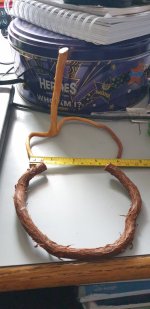nord
Seedling
I have a Giant Sequoia that I have been growing in a pot for 3 1/2 years. It started as a tiny seedling only 1 inch tall and grew during that time to be about 2 feet tall.
It has always been green and never a hint of brown.
It seemed like the tree stopped growing taller, very little new growth, so I recently replanted it into a 16 gallon pot.
I left the original bulb of soil intact and just put that bulb down into the new soil.
For the first week or so all seemed ok and I only watered the tree once a week as I had before for the last 3 1/2 years.
But by the end of the second week the tree started to turn brown.
The replant was on 5/3/25 and it is now 7/17/25.
I thought maybe the new soil was drying out too fast and it had been pretty hot here in San Diego, so for the last two weeks I started to water it every couple of days when the soil seemed dry if I stick my finger down about 6 inches.
But it continues to brown. The new pot is just a bigger version of the same plastic pot I had before which has excellent drainage.
Below are pics of the tree right before the repotting in the smaller pot, right after the repotting on 5/25 and how it looks today on 7/17/25.
I also included two pics at the end which show the new growth that is occurring on the tree since the replant.
I am seeing new branch buds starting to form on the trunk and the top of the tree has grown almost 3 inches in these 2 1/2 months.
Hopefully the new growth is a good sign?
Please help me save my tree! Her name is Lolita because she was so small when I first planted her.
It has always been green and never a hint of brown.
It seemed like the tree stopped growing taller, very little new growth, so I recently replanted it into a 16 gallon pot.
I left the original bulb of soil intact and just put that bulb down into the new soil.
For the first week or so all seemed ok and I only watered the tree once a week as I had before for the last 3 1/2 years.
But by the end of the second week the tree started to turn brown.
The replant was on 5/3/25 and it is now 7/17/25.
I thought maybe the new soil was drying out too fast and it had been pretty hot here in San Diego, so for the last two weeks I started to water it every couple of days when the soil seemed dry if I stick my finger down about 6 inches.
But it continues to brown. The new pot is just a bigger version of the same plastic pot I had before which has excellent drainage.
Below are pics of the tree right before the repotting in the smaller pot, right after the repotting on 5/25 and how it looks today on 7/17/25.
I also included two pics at the end which show the new growth that is occurring on the tree since the replant.
I am seeing new branch buds starting to form on the trunk and the top of the tree has grown almost 3 inches in these 2 1/2 months.
Hopefully the new growth is a good sign?
Please help me save my tree! Her name is Lolita because she was so small when I first planted her.








